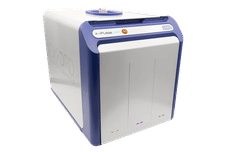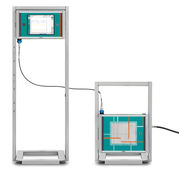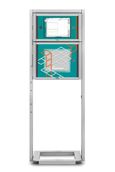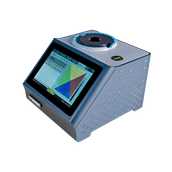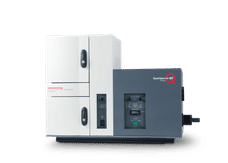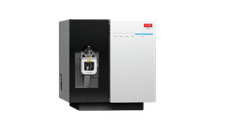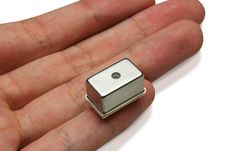UV/VIS Spectrometers at a Glance: Products, Function and Applications
UV/VIS spectrometers measure the light absorption in the ultraviolet and visible spectral range and are used in numerous scientific and industrial applications. On this page you will find an overview of products from various manufacturers.
You are looking for general information about the topic? Our UV/VIS spectrometer guide gives you all the info you need on how they work and what they're used for.
UV/VIS Spectrometers at a Glance: Products, Function and Applications

UV/VIS spectrometers measure the light absorption in the ultraviolet and visible spectral range and are used in numerous scientific and industrial applications. On this page you will find an overview of products from various manufacturers.
You are looking for general information about the topic? Our UV/VIS spectrometer guide gives you all the info you need on how they work and what they're used for.
Advertisement
UV/VIS spectrometers at a glance

Renting and Leasing Solutions for Laboratories by Bios Analytique
Specialists in the rental and leasing of scientific equipment for laboratories throughout Europe
Whether you have an unexpected requirement or limited budget, we have the perfect solution for you
Operating Lease (12-36 months) A real flexible offer ✓ Financial or Capital Lease (48-72 months) An all inclusive deal ✓ Extended Purchase (12-72months) When equipment must be part of the company ✓
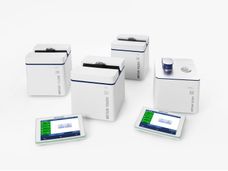
FastTrack™ by Mettler-Toledo
FastTrack UV/VIS Spectroscopy - Speed Up Your Measurements
Fast, reliable & efficient measurements with traceable accuracy in a small footprint
Streamlined workflow with full spectrum scans in just one second and no warm-up time ✓ Ready for the future with various automation options ✓ Conformity to guidelines in compliance with current pharmacopoeia specifications (e.g. USP, PharmEU) ✓
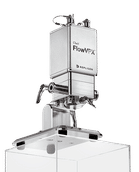
CTech FlowVPX In-line by Repligen
CTech FlowVPX System – Variable Pathlength Spectroscopy for In-line Concentration Monitoring
Real-time data for real-time decisions
Rapid, Continuous Data Acquisition—12 QC-grade concentration measurements per minute ✓ Broad Dynamic Range—concentration measurement from 0.1 mg/ml to 300 mg/ml without dilution ✓ Increased accuracy—Multiple absorbance slope-based concentration measurements based on R2 ≥ 0.999 ✓
Related product categories
Find more UV/VIS spectrometers content in our topic worlds
Topic World Spectroscopy
Investigation with spectroscopy gives us unique insights into the composition and structure of materials. From UV-Vis spectroscopy to infrared and Raman spectroscopy to fluorescence and atomic absorption spectroscopy, spectroscopy offers us a wide range of analytical techniques to precisely characterize substances. Immerse yourself in the fascinating world of spectroscopy!

Topic World Spectroscopy
Investigation with spectroscopy gives us unique insights into the composition and structure of materials. From UV-Vis spectroscopy to infrared and Raman spectroscopy to fluorescence and atomic absorption spectroscopy, spectroscopy offers us a wide range of analytical techniques to precisely characterize substances. Immerse yourself in the fascinating world of spectroscopy!
UV/VIS spectrometer guide: Everything you need to know, clearly explained
UV/Vis spectroscopy is a widely used analytical method employed in various scientific and industrial fields. This technique makes it possible to analyse the composition and concentration of substances by measuring light absorption in the ultraviolet (UV) and visible (Vis) spectral range. UV/Vis spectrometers play a central role in these analyses as they provide precise and reliable measurement results. These instruments are indispensable in quality control, research and development as well as in production monitoring. Due to their versatility and accuracy, UV/Vis spectrometers are of great importance in many industries.
What is a UV/Vis spectrometer?
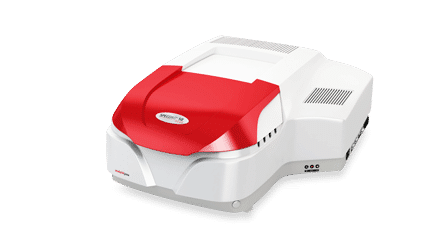
A UV/Vis spectrometer is an analytical instrument used to measure the light absorption of samples in the UV and visible spectral range. The basic operation of a UV/Vis spectrometer is to send light through a sample and measure the amount of light absorbed or transmitted. The UV spectral range extends from approximately 200 to 400 nm, while the visible spectral range extends from 400 to 700 nm. UV/Vis spectrometers can provide detailed information about the composition and concentration of substances, making them an important tool in analytical chemistry.
The differences between the UV and Vis spectral ranges are significant. While the UV range includes higher energy light and is often used to analyse molecules with conjugated double bonds, the Vis range is particularly useful for the study of coloured compounds. The selection of the appropriate spectral range depends on the type of sample to be analysed.
Operating principles of UV/Vis spectroscopy
UV/Vis spectroscopy is based on the principles of light absorption and transmission. When light is transmitted through a sample, the spectrometer allows certain wavelengths to be absorbed by the material while other wavelengths are transmitted. The amount of light absorbed is directly proportional to the concentration of the absorbing substance in the sample. This relationship is described by Lambert-Beer's law, which plays a fundamental role in UV/Vis spectroscopy.
Lambert-Beer's law is: A = ε * c * d, where A is the absorption, ε is the molar extinction coefficient, c is the concentration of the absorbing substance and d is the layer thickness of the sample. This law makes it possible to calculate the concentration of a substance in a solution if the other parameters are known.
There are different types of UV/Vis spectrometers, including single-beam and double-beam spectrometers. Single-beam spectrometers measure the absorbance of a sample compared to a reference sample, which is measured separately. Dual-beam spectrometers, on the other hand, measure the sample and the reference simultaneously, resulting in higher accuracy as variations in the light source and other environmental conditions are compensated for.
Types of UV/Vis spectrometers
There are different types of UV/Vis spectrometers, each offering different advantages and disadvantages. The most important types are monochromator, polychromator and array spectrometers.
Monochromator spectrometers:
These devices use a monochromator to select a single wavelength of light and direct it at the sample. Monochromator spectrometers offer high resolution and accuracy, but are slower than other types as each wavelength must be measured individually.
Polychromator spectrometers:
These spectrometers use a polychromator to direct multiple wavelengths at the sample simultaneously. This enables faster measurements as several wavelengths can be analysed simultaneously. However, polychromator spectrometers can offer lower resolution than monochromator spectrometers.
Array spectrometers:
These spectrometers use an array detector, such as a CCD or PDA (photodiode array) detector, to measure the entire spectrum simultaneously. Array spectrometers are very fast and compact, and they are particularly useful for applications that require parallel measurements.
A comparison of the advantages and disadvantages of these spectrometer types shows that the selection of the appropriate device depends heavily on the specific requirements of the application in question. Monochromator spectrometers offer the highest precision, while polychromator and array spectrometers are characterised by their speed and compactness.
Important technical specifications of UV/Vis spectrometers
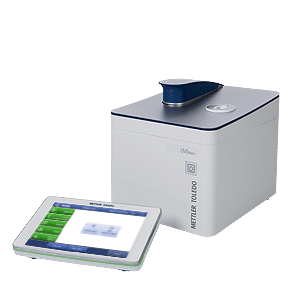
There are several technical specifications to consider when purchasing a UV/Vis spectrometer. These include the wavelength range, the resolution, the spectral bandwidth, the light sources and the detector types.
Wavelength range: The wavelength range of a UV/Vis spectrometer determines which substances can be analysed. A wide wavelength range enables a greater variety of samples to be analysed.
Resolution and spectral bandwidth: The resolution of a spectrometer indicates how well it can distinguish between two closely spaced wavelengths. High resolution is particularly important for analysing complex samples with many overlapping absorption bands.
Light sources: The choice of light source has a significant impact on the performance of a UV/Vis spectrometer. Deuterium lamps provide a continuous light source in the UV range, while halogen lamps are effective in the visible range. Xenon lamps provide broad coverage of both ranges and have a long lifetime.
Detector types: Photodiodes and photomultipliers are the most commonly used detectors in UV/Vis spectrometers. Photodiodes are cost-effective and robust, while photomultipliers offer higher sensitivity and a wider dynamic range.
Applications of UV/VIS spectrometers
UV/Vis spectrometry is used in many industries, including the food industry, the pharmaceutical industry, the chemical industry and biotechnology.
Food industry: In the food industry, UV/Vis spectrometry is used for colour determination and content analysis. It enables the quantification of colourants and additives as well as the monitoring of quality standards.
Pharmaceutical industry: The pharmaceutical industry uses UV/Vis spectrometers to test purity and analyse active ingredients. These instruments are crucial for the quality control of pharmaceuticals and the monitoring of production processes.
Chemical industry: In the chemical industry, UV/Vis spectrometers are important for quality control and waste water analysis. They enable the monitoring of reaction processes and the analysis of impurities.
Biotechnology: In biotechnology, UV/Vis spectrometry is used for protein analysis and DNA quantification. It is an indispensable tool in molecular biology research and biopharmaceutical development.
These versatile applications make UV/Vis spectrometers an indispensable tool in many areas of science and industry.
Product features and benefits of UV/Vis spectrometers
UV/Vis spectrometers offer numerous advantages, including high-precision measurements, fast and efficient analyses and flexibility for different sample types.
High-precision measurements: UV/Vis spectrometers are capable of extremely accurate and reliable measurements. This is particularly important for applications where the concentration of substances must be precisely determined.
Fast and efficient analyses: Modern UV/Vis spectrometers are designed to perform fast and efficient analyses. This increases productivity and enables large sample throughputs to be processed.
Flexibility for different sample types: UV/Vis spectrometers can analyse a wide range of sample types, including liquids, solids and gases. This flexibility makes them a versatile tool for different applications.
User-friendly software and automation options: Modern UV/Vis spectrometers are equipped with user-friendly software that facilitates data analysis. Automation options such as sipper systems and multiple cell changers increase efficiency and enable high throughput analysis.
Choosing the right UV/Vis spectrometer
The selection of the right UV/Vis spectrometer depends on the specific requirements of the application. Important criteria are the wavelength range, resolution, light sources and detector types.
Food industry: For applications in the food industry, robust and reliable devices that enable fast and accurate colour determination and content analysis are important.
Pharmaceutical industry: High precision and sensitivity are required in the pharmaceutical industry. UV/Vis spectrometers must be able to precisely measure low concentrations of active ingredients and impurities.
Chemical industry: In the chemical industry, UV/Vis spectrometers are important for monitoring production processes and quality control. Devices with high resolution and a wide wavelength range are particularly useful here.
Biotechnology: UV/Vis spectrometers with high sensitivity and precision are required for analysing proteins and DNA in biotechnology. Automation options are also an advantage here to enable the processing of large sample quantities.
Accessories and consumables
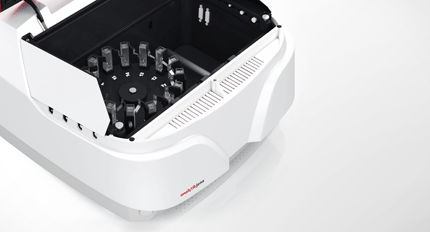
A variety of accessories and consumables are required for the efficient use of UV/Vis spectrometers.
Cuvettes: Cuvettes are an essential accessory for UV/Vis spectrometers. They are available in different materials such as quartz, glass and plastic and in different sizes to meet the requirements of different applications.
Holders and temperature controls: Specialised mounts and temperature control systems can improve the accuracy and reproducibility of measurements. Temperature controls are particularly important for applications where sample stability depends on temperature.
Automation solutions: Automation solutions such as sipper systems and multiple cell changers increase efficiency and enable high throughput analysis. These systems can automate sample preparation and handling, resulting in significant time savings.
Maintenance and calibration of UV/VIS spectrometers
Regular maintenance and calibration are critical to the accuracy and reliability of UV/Vis spectrometers.
Maintenance: Maintenance of a UV/Vis spectrometer includes regular cleaning of the optics, replacement of light sources and inspection of the electrical components. Well-maintained optics ensure precise measurements, while regular inspection of the light sources extends their service life.
Calibration: Accurate calibration is crucial for measurement accuracy. Standardised reference materials should be used to ensure that the measurement results are reproducible and accurate. Detailed calibration instructions help to optimise accuracy and avoid errors.
Avoiding errors and optimising measurement accuracy: Regular maintenance and careful calibration can prevent common errors. Tips for avoiding errors include the correct handling of samples and cuvettes and the use of suitable reference materials.
Good Laboratory Practices (GLP)
Good Laboratory Practices (GLP) are critical to the safe and efficient operation of UV/Vis spectrometers. They include best practices for handling the equipment, avoiding common errors and safety tips.
Best Practices: These include careful sample preparation, correct handling of cuvettes and regular checking of instrument functions. Careful sample preparation ensures that measurements are accurate and reproducible.
Common mistakes and how to avoid them: Common errors in the use of UV/Vis spectrometers can be avoided through careful training and regular inspection of the equipment. Common mistakes include incorrectly calibrated equipment, improper sample preparation and incorrect handling of cuvettes.
Safety tips and correct handling of cuvettes: Safety tips include the safe handling of chemical substances and the avoidance of contamination. Correct handling of cuvettes includes cleaning before and after use and correct storage to prevent damage.
Frequently asked questions (FAQ) about UV/VIS spectrometers
This section answers the most frequently asked questions about UV/Vis spectrometers. This includes explanations of technical terms, modes of operation and practical application tips.
What is the difference between UV and Vis spectral ranges?
The UV spectral range covers wavelengths from 200 to 400 nm and is often used to analyse molecules with conjugated double bonds. The visible spectral range extends from 400 to 700 nm and is used to analyse coloured compounds.
How does a UV/Vis spectrometer work?
A UV/Vis spectrometer measures the light absorption of a sample by transmitting light through the sample and recording the amount of light absorbed. These measurements are based on Lambert-Beer's law, which describes the relationship between the absorption and the concentration of the absorbing substance.
Which light sources are used in UV/Vis spectrometers?
The most common light sources are deuterium lamps for the UV range and halogen lamps for the visible range. Xenon lamps offer broad coverage of both ranges and have a long service life.
How often should a UV/Vis spectrometer be calibrated?
The frequency of calibration depends on the frequency of use and the specific requirements of the application. As a rule, a UV/Vis spectrometer should be calibrated regularly, but at least once a month.
What factors influence the accuracy of UV/Vis measurements?
The accuracy of UV/Vis measurements can be influenced by various factors, including the quality of the cuvettes, the stability of the light source, the calibration of the instrument and careful sample preparation.
What applications are there for UV/Vis spectrometers in biotechnology?
In biotechnology, UV/Vis spectrometers are used to analyse proteins and quantify DNA. These applications are crucial for molecular biology research and the development of biopharmaceutical products.
What other types of spectrometers are there?
An overview of other popular spectrometer categories can be found here:
Haven't found the right product yet?
The bionity.com Product Search
Start your targeted search now with a wide selection of filter options. Here you can easily find the right product for your search, including manufacturer information and options for requesting a quote or downloading the corresponding brochure.






